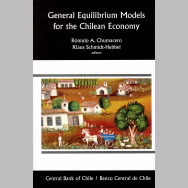Volumen 9: General Equilibrium Models For The Chilean Economy
Publicaciones
Volumen 9: General Equilibrium Models For The Chilean Economy
Descripción
General equilibrium theory and modeling have proved to be useful for understanding economic interactions between markets and agents and the determination of prices and quantities. Applied general equilibrium models (GEM) have been developed and used to address a wide range of theoretical questions and empirical/policy issues, in the fields of macroeconomics, international trade, public finance, and environmental analysis, among others.
This volume—the first of its kind in Chile—comprises a representative collection of recent GEM research and applications that illustrate the usefulness and relevance of frontier general equilibrium tools for better understanding aggregate structures and policy responses. It should be of interest to academics and policymakers in Chile and elsewhere, for several reasons. First, Chile is known for implementing bold and innovative economic policies. The assessment and quantification of potential effects is particularly valuable when performed by using the types of models presented herein. Second, this book includes a variety of methodological choices available to address key issues. The thoughtful combination of empirical and theoretical considerations informs the user about model strengths and weaknesses and the types of questions that they are able to address. Finally, the volume also presents some novel methodological contributions to the empirical and theoretical literature on general equilibrium models.
Editado por Rómulo A. Chumacero y Klaus Schmidt-Hebbel.
Comentarios
This volume includes a valuable collection of studies that apply general equilibrim models to a range of Chilean policy questions. These studies assess systematically a number of the innovative policies that have been introduced in Chile using a variety of methodological approaches. The compilation of the different approaches into one set of studies, moreover, illustrates a number of strengths and weaknesses of the different approaches. The collection will be very useful, therefore, for academics and policymakers not only with interests in Chile. But also with interests in general equilibrium analysis of other economies.
Jere R. Behrman, University of PennsyIvania.
This book contains a rich set of applied general equilibrium studies that address a number of important Chilean policy issues. The book is of value to both academics and policy makers in Chile and elsewhere. The general equilibrium methods developed and applied in these studies can be used to assess quantitatively the consequences of innovative economic policies that are under consideration, or warrant consideration.
Edward C. Prescott, Arizona State University, Nobel Prize for Economic Sciences.
In the last twenty years applied general equilibrium models have evolved dramatically to cope with changing theoretical paradigms and structural changes in the real worid. As a result of this process a new generation of models has emerged, and they have become essential instruments to illuminate key policy issues. This volume presents a wide range of empirical models for the Chilean econorny of the latest generation, coming from different traditions in modeling. There is significant value in this book coming from the contributions of the different chapters to their specific subjects, but there is also significant value in the combination of papers. It provides the reader with a unique perspective of the challenges faced when applying these models to a developing economy that has gone through deep structural transformations in the last decades, as well as the ingenious responses to those challenges. This makes this volume an extremely useful aid to those working in applied modeling elsewhere, but especially in the developing world and in transition economies.
Joaquín Vial, BBVA
Volumen 9: General Equilibrium Models For The Chilean Economy
Recuadros y gráficos

